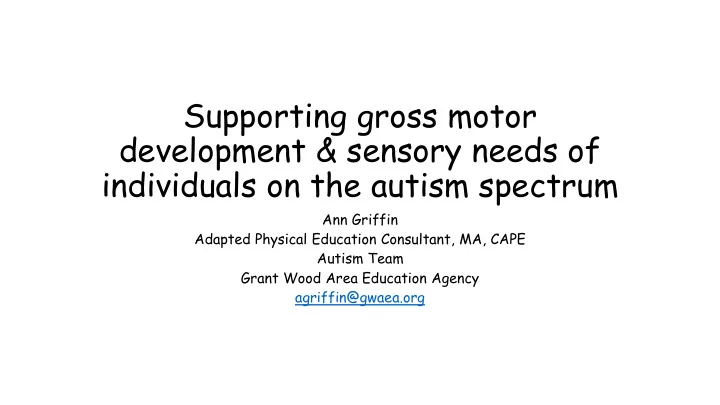

Supporting gross motor development & sensory needs of individuals on the autism spectrum Ann Griffin Adapted Physical Education Consultant, MA, CAPE Autism Team Grant Wood Area Education Agency agriffin@gwaea.org
Puzzles, Toys, and Brains, OH MY! Lens: motor development, play skill development, neurological development, non-verbal communication, interestingly different learners… Experience: LOTS of years, LOTS of teachers, LOTS of learners UNcommon sense
Learning Targets Learn how autism affects gross motor development Learn how gross motor activities benefit autistic people Understand how IDEA applies to physical education Hands-on activities you can do at home
The EXPERTS are among us HOW CAN WE ALL PLAY?
PLAY with ME I tried to teach my child from books, he gave me only puzzled looks, I tried to teach my child with words, they passed him by oft’ unheard , despairingly I turned aside, “How shall I teach this child” I cried , inside my hands he placed the key: “Come,” he said, “Play with me.” author unknown
ASD/Autism…What is it? Neurobiological Disorder Causing issues in the areas of Communication Social Interaction Play Emotional Regulation Sensory Regulation Motor Planning
Physical Education and Adapted Physical Education work on all of these things Make sure that you address physical education in your child’s IEP
Gross motor activities, naturally provide sensory input
Exercise is good for your brain and your body
and the Research says.. • Physical activity improves academic achievement • Increasing or maintaining time devoted to physical education may help and doesn’t adversely impact academic performance • Physical activity improves concentration, attention, and classroom behavior • Exercise controls the emotional and physical feelings of stress • Exercise is as effective as certain medications for treating anxiety and depression. • Regular exercise can improve functioning of brain systems that regulate impulse, memory and attention CDC benefits of exercise
Got PE? NOT so important to the IEP team, but HUGELY important to kids!
Exercise and Physical Activity • Decreasing Challenging Behavior • Self Regulation • Increasing Attention and Concentration • Increasing interactions with PEOPLE • Physical Health • MENTAL HEALTH
National Physical Education Standards 1. I have the skills to move and play 2. I show that I know how to move and have a plan when I play games 3. I show that I know how to get fit and stay fit 4. I act fairly and respectfully when I play 5. I know why it is important to stay physically active
NOT A NEW LAW: 94-142 (1975) and IDEA 2004 Physical Education remains the only curricular area specifically required by federal law for EVERY student with a disability 20 U.S.C. 1401(29) Special Education . The term 'special education' means specially designed instruction, at no cost to parents, to meet the unique needs of a child with a disability, including - (A) instruction conducted in the classroom, in the home, in hospitals and institutions, and in other settings; and (B) instruction in physical education.
PE and the IEP All students with disabilities MUST receive instruction in physical education, specially designed if necessary If students are NOT making progress in the general physical education curriculum, then the IEP team (including Parents and PE teacher) need to decide what WOULD work, and document that in the IEP
Physical education THE place to LEARN to MOVE LOTS of opportunities to provide students with proactive motor and movement outlets (self regulate) Opportunity to teach students how to become aware of their own needs and learn to calm themselves
Iowa City Community School District GPE • Kindergarten: 2x/week for 54 minutes/week Grades 1-4: 3x/week for 81 Grades 5/6: 4x/week for 108 JH every other day year long for 43 min/class • HS one trimester everyday (unless they can waive it) for 49 minutes (7+waiver in IC)
Who Teaches? • Physical Educators are licensed to provide instruction • Physical Educators are WILLING and have LOTS of skills • NEED resources!!! • Professional Development in special education and adapting physical education • Accurate data to inform instruction, scheduling, and FTE • Planning time to collaborate and create accommodations • Schedule accommodations to facilitate set up and take down • Alternative programming and curriculum development • Access to Support for General Education Teachers (IEP)
How Can We ALL Play?
It’s all in the TOYs The key to engaging children/students in activity is equipment selection WITH A PURPOSE!!!! What’s in your house, basement, attic or garage, and how else might you use it?
Equipment Selection: unique interests What do I have that matches interests? TURN Ons TURN ONs: Interesting and Engaging Equipment sorted by attribute
Black Holes?!?
Equipment Selection… unique interests • Black holes/Tubes • Spinning things • Strings • Wheels • Small Spaces • Pressure • Motion • HEAVY/Pressure • Action/Reaction • Jumping/Bouncing • Multi- sensory…looks good/feels good
HOW can we all play? Engage with carefully selected high probability toys or pieces of equipment BUILD on interests Follow their lead Expand Repertoire of interests and play schemes Facilitate Practice: attach or suspend TEACH Play interaction skills Get a partner Ask for a turn/Wait for a turn/Take turns Tag
Engage…build on interests
Engage…build on interests
Engage…build on interests
Engage: Build on interest
Numbers
Facilitate Play Skills
It should look like this!
OUTCOMES? SMILING LING SWEATING ING
Hey Miss Ann, What’s in the Bag?
Keymakers Some people see a closed door and turn away. Others see a closed door, try the knob, if it doesn’t open...they turn away. Still others see a closed door, try the knob, if it doesn’t open, they find a key, if the key doesn’t fit...they turn away. A rare few see a closed door, try the knob, if it doesn’t open, they find a key, if the key doesn’t fit... they make one.
Equipment to Take • Hoops • Coop Band • Exercise band • Exercise Ball • Blue standing thing • Eric Carle • Exercise Playing cards…exercise boxes? • Tag sticks • Lazy Susan
Recommend
More recommend